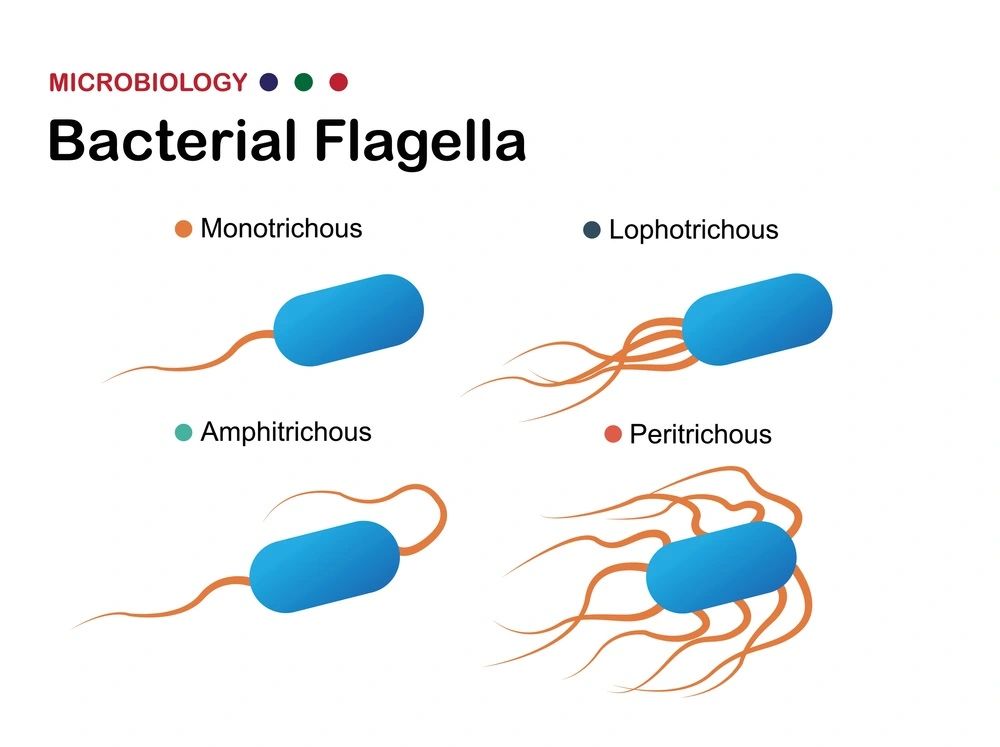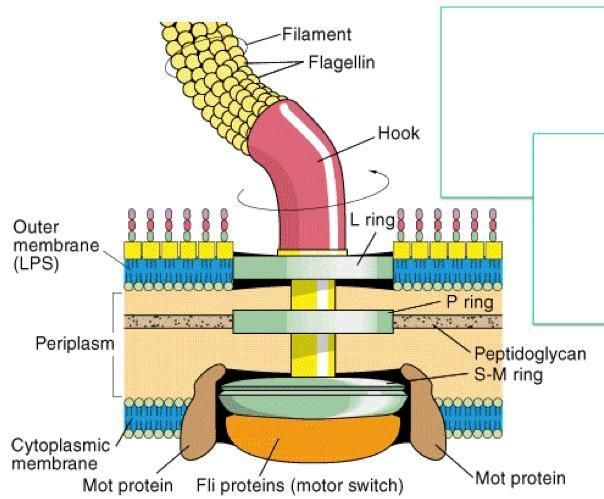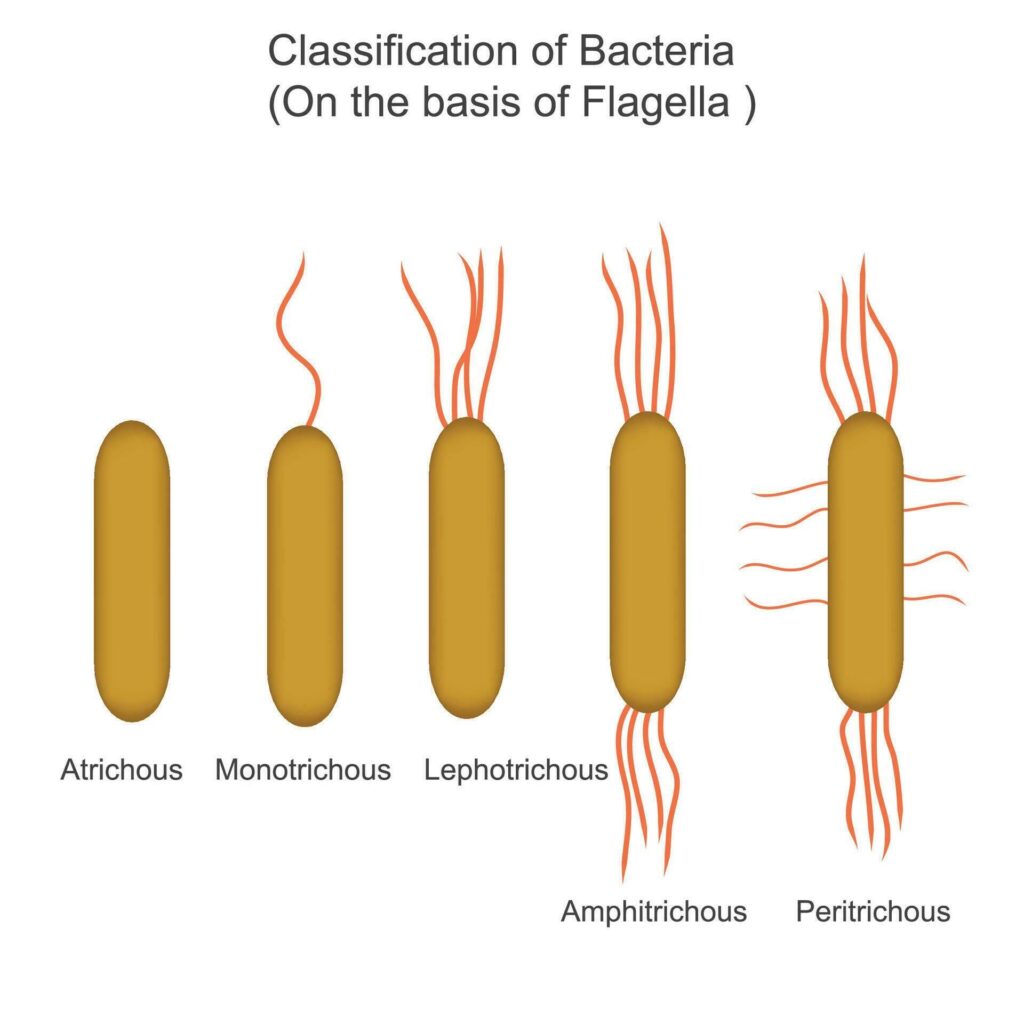Introduction
Bacterial flagella are long, whip-like, tail-like structures attached to some bacteria that help them move through liquid by rotating like a tiny motor. Bacteria are tiny living organisms, and some of them have a special structure called a flagellum (plural: flagella) that helps them move. Think of a flagellum like a little tail or whip attached to a bacterium, which spins like a motor and lets the bacterium swim through liquids. Not all bacteria have flagella, but for those that do, these structures are very important for survival, especially in finding food or escaping harmful conditions.

Summary of Bacterial flagella
- Bacterial flagella are tail-like structures that rotate like motors to help bacteria move, using energy from hydrogen ions.
- They consist of three main parts: filament, hook, and basal body, and vary in arrangement (e.g., monotrichous, lophotrichous, peritrichous).
- Flagella also assist in environmental response, surface attachment, and can play a role in bacterial infection and disease.
Table of Contents
Structure of Bacterial Flagella

A bacterial flagellum is a long, thin, thread–like structure made mostly of a protein called flagellin. Although it may look simple under a microscope, it actually has a complex structure with several key parts. Let’s break it down into three main parts:
1. Filament
- The filament is the long, whip-like part that extends out from the surface of the bacterium.
- It is made entirely of flagellin protein.
- The filament is what rotates to propel the bacterium forward or backward.
- It is hollow inside and can be very long compared to the size of the bacterium.
2. Hook
- The hook connects the filament to the base of the flagellum.
- It works like a flexible joint, allowing the filament to rotate at different angles.
- This flexibility is important for movement in various directions.
3. Basal Body
- The basal body is the motor part of the flagellum.
- It is embedded in the bacterial cell wall and cell membrane.
- The basal body contains several rings and a rod that work together to spin the flagellum.
- It uses energy from protons (H⁺ ions) moving across the cell membrane to rotate.
- This rotation can be clockwise or counterclockwise, affecting the direction of movement.
In Gram-negative bacteria (which have two membranes), the basal body has four rings: L-ring, P-ring, MS-ring, and C-ring. In Gram-positive bacteria (which have one membrane), it usually has two rings: MS and C rings.
Types of Flagella Based on Arrangement
Bacteria can have different numbers and arrangements of flagella on their bodies. These arrangements affect how the bacteria move. There are five main types:

1. Monotrichous
- One single flagellum at one end (pole) of the cell.
- Example: Vibrio cholerae
- These bacteria swim in a straight line when the flagellum rotates.
2. Lophotrichous
- A cluster of flagella at one end.
- Example: Pseudomonas species
- The group of flagella spins together, helping the bacteria move faster.
3. Amphitrichous
- One flagellum at each end of the cell.
- Example: Alcaligenes faecalis
- These bacteria can reverse direction by switching which flagellum is active.
4. Peritrichous
- Flagella all over the surface of the bacterium.
- Example: Escherichia coli
- These bacteria move in a tumbling and running pattern, changing directions frequently.
5. Atrichous
- No flagella at all.
- These bacteria are non-motile (they don’t move on their own).
Functions of Bacterial Flagella
The flagella serve several important functions in bacteria:
1. Motility (Movement)
- The main role of flagella is to help bacteria move.
- Bacteria swim by rotating their flagella like a propeller.
- This allows them to move toward nutrients (a process called positive chemotaxis) or away from harmful substances (negative chemotaxis).
2. Chemotaxis
- Bacteria use their flagella to move in response to chemical signals.
- They can sense whether they are moving toward something good (like sugar) or something harmful (like acid) and change direction accordingly.
3. Attachment and Colonization
- Some flagella help bacteria stick to surfaces, especially in the early stages of forming a biofilm (a group of bacteria stuck together).
- This is important for bacteria that cause infections in humans or animals.
4. Virulence
- In some harmful bacteria, flagella help in invading host tissues.
- Movement allows the bacteria to reach the site of infection more effectively.
- The flagellin protein can also trigger an immune response in the host.
5. Environmental Adaptation
- Flagella allow bacteria to move toward better living conditions.
- For example, in soil or water, bacteria might swim to areas with more oxygen or nutrients.
How Flagella Work: The Rotating Motor
The movement of bacterial flagella is powered by a rotary motor located in the basal body. This motor uses the proton motive force, meaning it gets energy from the flow of hydrogen ions across the cell membrane.
Here’s how it works:
- Protons enter the cell through channels in the motor.
- This flow of ions causes the motor to spin.
- As the motor spins, it turns the hook and filament, causing the flagellum to rotate.
- Depending on the direction of the spin, the bacterium either swims forward or changes direction.
Bacterial Movement Patterns
The movement of flagella creates different patterns in how bacteria travel:
1. Run
- When all the flagella rotate in the same direction (usually counterclockwise), the bacterium moves in a straight line.
- This is called a run.
2. Tumble
- When the rotation switches direction (usually clockwise), the flagella spread out, and the bacterium spins randomly.
- This is called a tumble, and it helps the bacterium change direction.
By alternating between runs and tumbles, bacteria explore their surroundings in a smart way.
Comparison with Eukaryotic Flagella
It’s worth noting that bacterial flagella are very different from the flagella found in human or animal cells (called eukaryotic flagella).
| Feature | Bacterial Flagella | Eukaryotic Flagella |
|---|---|---|
| Structure | Simple, made of flagellin | Complex, made of microtubules |
| Movement | Rotates like a motor | Whips back and forth |
| Energy source | Proton motive force | ATP (cell energy) |
| Location | Outside the cell membrane | Inside the cell membrane |
Flagella and Disease
Flagella play an important role in many disease-causing bacteria. For example:
- Helicobacter pylori uses flagella to move through the mucus in the stomach and cause ulcers.
- Salmonella typhi uses flagella to invade the intestinal walls.
- Vibrio cholerae swims using a single polar flagellum to reach its infection site.
Because flagella are important for infection, scientists often study them to understand how diseases spread and how to stop them.
Flagella as Targets for Medicine and Research
Since flagella are so important for bacterial survival and infection, they can be targets for antibiotics or vaccines. Also, scientists use flagella in research to study motility, gene regulation, and immune system reactions.
Conclusion
Bacterial flagella are fascinating structures that look simple but perform complex functions. They are mainly used for movement, helping bacteria swim toward food or escape danger. Structurally, they have three main parts: filament, hook, and basal body. There are several types of flagella based on how they are arranged on the bacterial surface—monotrichous, lophotrichous, amphitrichous, peritrichous, and atrichous. Flagella play a vital role not just in motility but also in colonization, environmental adaptation, and even causing disease.
Understanding bacterial flagella helps scientists develop new ways to fight infections and explore how bacteria survive in different environments. Despite being tiny, these tail-like structures are essential tools for bacterial life.
FREQUENTLY ASKED QUESTIONS
What is the role of flagella in a bacterial cell ?
The role of flagella in a bacterial cell is to help the bacteria move through liquids, find food, escape harmful conditions, and sometimes stick to surfaces or cause infections.
What is the function of bacterial flagella ?
The main function of bacterial flagella is to help bacteria move (motility), but they also assist in finding food (chemotaxis), escaping harmful environments, attaching to surfaces, and in some cases, causing infections in the host.
How does bacterial flagella move ?
Bacterial flagella move by rotating like a tiny motor, powered by the flow of hydrogen ions (proton motive force) across the cell membrane. This rotation can be clockwise or counterclockwise, allowing the bacterium to either move forward (run) or change direction (tumble).
Related Articles




